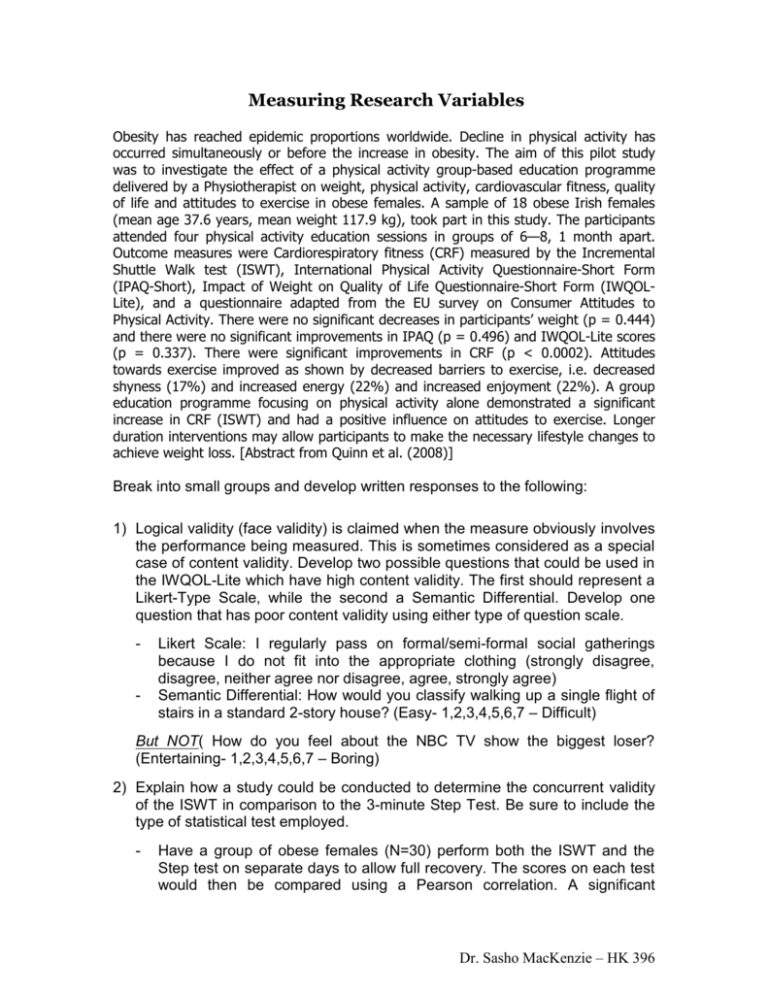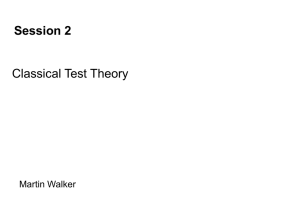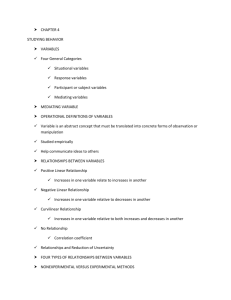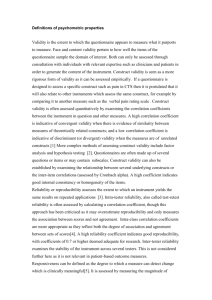Measuring Research Variables
advertisement

Measuring Research Variables Obesity has reached epidemic proportions worldwide. Decline in physical activity has occurred simultaneously or before the increase in obesity. The aim of this pilot study was to investigate the effect of a physical activity group-based education programme delivered by a Physiotherapist on weight, physical activity, cardiovascular fitness, quality of life and attitudes to exercise in obese females. A sample of 18 obese Irish females (mean age 37.6 years, mean weight 117.9 kg), took part in this study. The participants attended four physical activity education sessions in groups of 6—8, 1 month apart. Outcome measures were Cardiorespiratory fitness (CRF) measured by the Incremental Shuttle Walk test (ISWT), International Physical Activity Questionnaire-Short Form (IPAQ-Short), Impact of Weight on Quality of Life Questionnaire-Short Form (IWQOLLite), and a questionnaire adapted from the EU survey on Consumer Attitudes to Physical Activity. There were no significant decreases in participants’ weight (p = 0.444) and there were no significant improvements in IPAQ (p = 0.496) and IWQOL-Lite scores (p = 0.337). There were significant improvements in CRF (p < 0.0002). Attitudes towards exercise improved as shown by decreased barriers to exercise, i.e. decreased shyness (17%) and increased energy (22%) and increased enjoyment (22%). A group education programme focusing on physical activity alone demonstrated a significant increase in CRF (ISWT) and had a positive influence on attitudes to exercise. Longer duration interventions may allow participants to make the necessary lifestyle changes to achieve weight loss. [Abstract from Quinn et al. (2008)] Break into small groups and develop written responses to the following: 1) Logical validity (face validity) is claimed when the measure obviously involves the performance being measured. This is sometimes considered as a special case of content validity. Develop two possible questions that could be used in the IWQOL-Lite which have high content validity. The first should represent a Likert-Type Scale, while the second a Semantic Differential. Develop one question that has poor content validity using either type of question scale. - - Likert Scale: I regularly pass on formal/semi-formal social gatherings because I do not fit into the appropriate clothing (strongly disagree, disagree, neither agree nor disagree, agree, strongly agree) Semantic Differential: How would you classify walking up a single flight of stairs in a standard 2-story house? (Easy- 1,2,3,4,5,6,7 – Difficult) But NOT( How do you feel about the NBC TV show the biggest loser? (Entertaining- 1,2,3,4,5,6,7 – Boring) 2) Explain how a study could be conducted to determine the concurrent validity of the ISWT in comparison to the 3-minute Step Test. Be sure to include the type of statistical test employed. - Have a group of obese females (N=30) perform both the ISWT and the Step test on separate days to allow full recovery. The scores on each test would then be compared using a Pearson correlation. A significant Dr. Sasho MacKenzie – HK 396 correlation of r = .95 or higher would suggest a strong level of concurrent validity. Pearson correlation of ISWT (1,2,3) to 3 min Step test value (56, 57, 58) leads to a correlation of 1. This is an inter-class correlation but much better used for intra-class correlation(Krohn back alpha method) 3) Explain how a study could be conducted to determine the ability of the Consumer Attitudes to Physical Activity Questionnaire to predict an individual’s adherence to a future exercise program. What type of validity is this? Be sure to include the type of statistical test employed. Conduct a questionnaire, perform exercise program, and then perform correlation predicted validity 4) Explain how a study could be conducted, using the known group difference method, to estimate the construct validity of the ISWT. Be sure to include the type of statistical test employed. Construct validity does it actually measure what we want? Often looks at intangible things (no direct measure ie. Self-esteem) ISWT measure CRF independent t-test varsity cross country runners vs. obese Irish females and they should show that the cross country runners are significantly greater 5) Using one of the questionnaires from the Abstract, provide clear examples of how stability, alternate forms, and internal consistency types of reliability can be distinguished. ***Exam question: - Stability Alternate forms Internal Consistency Test called limits of agreement in article Tomi Putting system - data needs to be reliable and valid in order to be used in the future - best way to measure is highly difficult - limits of agreement: shows CI lines on graph indicate 95% confidence ***Read the study!!! Dr. Sasho MacKenzie – HK 396









